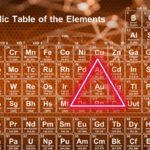
Risks associated with gold nanoparticles

By the AVICENN team – Last modification August 2023
Risks associated with gold nanoparticles
For some time now, gold nanoparticles have been praised for their fantastic properties and their numerous applications (notably in the medical field but also in cosmetics). However, let’s not underestimate their toxicity, it requires appropriate safeguards.
A paper published in early 2019 in Nature Nanotechnology shows that titanium dioxide, silica, and gold nanoparticles can induce changes in the endothelium and thus leakage of tumor cells, leading to metastasis. According to Frédéric Lagarce, professor of biopharmacy and hospital practitioner in Angers, “What is interesting / original is to show a potential risk of nanotechnologies in the treatment of tumors while these technologies are often presented as the answer to improve the performance of anticancer drugs. It is now necessary to verify if these endothelial modifications are also found with polymeric or lipidic nanoparticles, which are more commonly used to encapsulate active ingredients and target tumors. If this was unfortunately the case, the whole strategy of nanomedicine (very cancer-oriented) would be called into question.
At the end of 2019, researchers revealed that gold nanoparticles are not as stable in cells as previously thought1Cf. What happens to gold nanoparticles in the body, CNRS, December 2019; Gold nanoparticles are not so stable in cells, Pour la Science, January 2020; What happens to gold nanoparticles from drugs in our bodies, Florence Gazeau and Florent Carn, The Conversation, March 3, 2020.
Published in early 2020, research conducted in Germany showed that the absorption of gold nanoparticles in cells disrupted their metabolism “as if they had run a marathon” (increase in the number of mitochondria and endosomes, decrease in other organelles such as lipid droplets and multivesicular bodies)2X-ray microscopy at BESSY II: Nanoparticles can change cells, Helmholtz-Zentrum Berlin für Materialien und Energie, February 12, 2020 and Cells Undergo Major Changes in the Quantity of Cytoplasmic Organelles after Uptake of Gold Nanoparticles with Biologically Relevant Surface Coatings, Kepsutlu B et al, ACS Nano, 14, 2, 2248-2264, 2020.
In 2020, researchers from Imperial College London have shown that3Cf. Size determines how nanoparticles affect biological membranes, Dunning, H., Imperial College London, September 17, 2020 (press release) and Size dependency of gold nanoparticles interacting with model membranes, Contini, C et al, Nature Communications Chemistry, 130, 2020:
- larger nanoparticles (50-60 nm) sometimes adhere to the outside of the cell membrane, causing minimal disruption
- medium-sized nanoparticles (25-35 nm) adhere more often to the surface and cause some distortion
- smaller nanoparticles (5-10 nm) significantly deform the cell membrane, sometimes bending it inward with several stacked nanoparticles, causing tubular distortion.
Smaller nanoparticles can thus cause undesirable toxic side effects in the body when not “functionalized” (i.e. targeting specific receptors).
A scientific article published in Nature Communications in early 20214Cf. Particle number-based trophic transfer of gold nanomaterials in an aquatic food chain, Monikh FA et al, Nature Communications, 12: 899, 2021 shows the propensity of gold nanoparticles to move up the food chain and accumulate in aquatic organisms (especially in fish brains). The first author of the article, Dr. Fazel A. Monikh of the University of Eastern Finland, calls for better supervision of nanomaterials: risk assessment must be done BEFORE the marketing of products containing them5Cf. The invisible killer lurking in our consumer products, University of Eastern Finland, February 9, 2021.
In March 2021, the European Scientific Committee on Consumer Safety (SCCS) issued an opinion on the risks associated with the use of gold nanoparticles in cosmetics, following the request by the European Commission at the end of 2019 following the notifications received on the Cosmetic Products Notification Portal (CPNP) of the European Commission.
According to the SCCS, a safety assessment of gold nanomaterials, colloidal gold and surface-modified gold cannot be performed due to insufficient or missing essential information. Based on the scientific literature, which suggests possible systemic absorption of gold nanoparticles (which may lead to accumulation in certain organs – notably the liver and spleen) and potential mutagenic/genotoxic effects of gold nanomaterials, the SCCS concludes that there is reason to be concerned that the use of (nano) gold, colloidal (nano) gold and surface-modified (nano) gold materials in cosmetic products may present a risk to human health6Cf. Preliminary opinion on Gold (nano), Colloidal Gold (nano), Gold Thioethylamino Hyaluronic Acid (nano) and Acetyl heptapeptide-9 Colloidal gold (nano), Scientific Committee on Consumer Safety (SCCS), March 2021.
In 2022, the European Commission is expected to ban the use of gold nanoparticles, colloidal gold, gold thioethylaminohyaluronic acid, and colloidal acetylheptapeptide-9 in cosmetics.
In 2023, French scientists have shown, in E175-exposed femal mice, gut microbiota alterations likely to aggravate metabolic disorders, for example, in the context of an unbalanced diet7Cf. A 90-day oral exposure to food-grade gold at relevant human doses impacts the gut microbiota and the local immune system in a sex-dependent manner in mice, Evariste L et al., P&FT, 20(27), July 2023.
To be continued.
Any questions or comments? This information sheet compiled by AVICENN is intended to be completed and updated. Please feel free to contribute.
Other news on the topic
Upcoming Nano Agenda

- Webconference for analysis laboratories, plant fertilizer manufacturers and distributors, public authorities…
- Moderated by David Krupka, nanotechnologies development manager at AFNOR Normalisation and Emilie Langlois-Bertrand, nantechnologies standardization project manager.
- In partnership with Armand Masion, CNRS Research Director, and Sandrine Mocoeur, Health, Safety, Environment and Quality Manager at SYNGENTA.
- This exchange will also be an opportunity to explore the creation of a national platform to identify standardization needs.
- Website: www.afnor.org/evenement/nanotechnologies-agriculture-cadre-pratique-responsable/
- 8th Congress of Occupational Medicine and Health (CNMST 2026)
- Theme 5: Emerging pathologies and risks, Mr Henri Bastos (ANSES), Pr Lynda Bensefa-Colas (AP-HP), Dr Catherine Nisse (CHU Lille)
- Website: www.medecine-sante-travail.com
- 20th meeting of the “nano and health” dialogue committee
- Organizer: ANSES
Sheet originally created in January 2018
Notes and references
- 1Cf. What happens to gold nanoparticles in the body, CNRS, December 2019; Gold nanoparticles are not so stable in cells, Pour la Science, January 2020; What happens to gold nanoparticles from drugs in our bodies, Florence Gazeau and Florent Carn, The Conversation, March 3, 2020
- 2X-ray microscopy at BESSY II: Nanoparticles can change cells, Helmholtz-Zentrum Berlin für Materialien und Energie, February 12, 2020 and Cells Undergo Major Changes in the Quantity of Cytoplasmic Organelles after Uptake of Gold Nanoparticles with Biologically Relevant Surface Coatings, Kepsutlu B et al, ACS Nano, 14, 2, 2248-2264, 2020
- 3Cf. Size determines how nanoparticles affect biological membranes, Dunning, H., Imperial College London, September 17, 2020 (press release) and Size dependency of gold nanoparticles interacting with model membranes, Contini, C et al, Nature Communications Chemistry, 130, 2020
- 4Cf. Particle number-based trophic transfer of gold nanomaterials in an aquatic food chain, Monikh FA et al, Nature Communications, 12: 899, 2021
- 5Cf. The invisible killer lurking in our consumer products, University of Eastern Finland, February 9, 2021
- 6Cf. Preliminary opinion on Gold (nano), Colloidal Gold (nano), Gold Thioethylamino Hyaluronic Acid (nano) and Acetyl heptapeptide-9 Colloidal gold (nano), Scientific Committee on Consumer Safety (SCCS), March 2021
- 7Cf. A 90-day oral exposure to food-grade gold at relevant human doses impacts the gut microbiota and the local immune system in a sex-dependent manner in mice, Evariste L et al., P&FT, 20(27), July 2023



